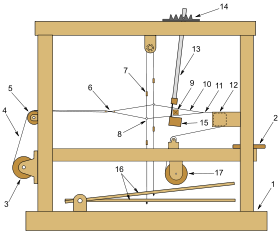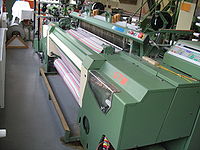Loom


A loom is a device used to weave cloth. The basic purpose of any loom is to hold the warp threads under tension to facilitate the interweaving of the weft threads. The precise shape of the loom and its mechanics may vary, but the basic function is the same.
Weaving
- See Weaving for more information.
- See Textile manufacturing terminology for more terms connected with looms.
Weaving is done by intersecting the longitudinal threads, the warp, i.e. "that which is thrown across", with the transverse threads, the weft, i.e. "that which is woven".
Shuttle looms

The major components of the loom are the warp beam, heddles, harnesses, shuttle, reed and takeup roll. In the loom, yarn processing includes shedding, picking, battening and taking-up operations.
- Shedding. Shedding is the raising of the warp yarns to form a shed through which the filling yarn, carried by the shuttle, can be inserted. The shed is the vertical space between the raised and unraised warp yarns. On the modern loom, simple and intricate shedding operations are performed automatically by the heddle or heald frame, also known as a harness. This is a rectangular frame to which a series of wires, called heddles or healds, are attached. The yarns are passed through the eye holes of the heddles, which hang vertically from the harnesses. The weave pattern determines which harness controls which warp yarns, and the number of harnesses used depends on the complexity of the weave. Two common methods of controlling the heddles are dobbies and a Jacquard Head.
- Picking. As the harnesses raise the heddles or healds, which raise the warp yarns, the shed is created. The filling yarn in inserted through the shed by a small carrier device called a shuttle. The shuttle is normally pointed at each end to allow passage through the shed. In a traditional shuttle loom, the filling yarn is wound onto a quill, which in turn is mounted in the shuttle. The filling yarn emerges through a hole in the shuttle as it moves across the loom. A single crossing of the shuttle from one side of the loom to the other is known as a pick. As the shuttle moves back and forth across the shed, it weaves an edge, or selvage, on each side of the fabric to prevent the fabric from raveling.
- Battening. As the shuttle moves across the loom laying down the fill yarn, it also passes through openings in another frame called a reed (which resembles a comb). With each picking operation, the reed presses or battens each filling yarn against the portion of the fabric that has already been formed. The point where the fabric is formed is called the fell. Conventional shuttle looms can operate at speeds of about 150 to 160 picks per minute.[1]
With each weaving operation, the newly constructed fabric must be wound on a cloth beam. This process is called taking up. At the same time, the warp yarns must be let off or released from the warp beams. To become fully automatic, a loom needs a filling stop motion which will brake the loom, if the weft thread breaks.[2] An automatic loom requires 0.125hp to 0.5hp to operate.
Types of loom

Backstrap loom
An extremely simple design, using a rigid heddle. The long warp threads are tied to a post, tree or similar immovable object, and the other end attached to the weaver's belt or a special strap around the back. The weaver then leans back to bring tension to the warp threads/yarn and moves the heddle up and down, passing the weft thread through the shed to complete the weave. Such looms are used to make relatively narrow fabric strips, but stripes, checks, plaids can be made.
Warp weighted loom
The warp-weighted loom is a vertical loom that originates from Ancient Greece, and spread through out Europe thereafter [3]. It’s defining characteristic are hanging weights which keeps the warp thread taut. Frequently, extra warp-thread is wound around the weights. When a weaver has reached the bottom of their creation, they can roll the completed section around the top beam, and unwind the extra warp thread from around the weights to continue. This frees the weaver from size vertical size constraints.
Handloom
| Elements of a foot-treadle floor loom |

|
The earliest looms were wooden vertical-shaft looms, with the heddles fixed in place in the shaft. The warp threads pass alternately through a heddle and through a space between the heddles (the shed), so that raising the shaft raises half the threads (those passing through the heddles), and lowering the shaft lowers the same threads -- the threads passing through the spaces between the heddles remain in place.
Haute lisse and basse lisse looms
Looms used for weaving traditional tapestry are classified as haute lisse looms, where the warp is suspended vertically between two rolls, and the basse lisse looms, where the warp extends horizontally between the rolls.
Power looms


Edmund Cartwright built and patented a power loom in 1785, and it was this that was adopted by the nascent cotton industry in England. A silk loom was made by Jacques Vaucanson in 1745, which used the same ideas but it wasn't developed further. The invention of the flying shuttle by John Kay had been critical to the development of a commercially successful power loom.[4] Cartwright's loom was impractical but the ideas were developed by numerous inventors in the Manchester area in England, where by 1818 there were 32 factories containing 5732 looms.[5]
Horrocks loom was viable but it was the Roberts Loom in 1830 [6]that marked the turning point. Before this time hand looms had out numbered power looms. Incremental changes to the three motions continued to be made. The problems of sizing, stop-motions, consistent take-up and a temple to maintain the width remained. In 1841, Kenworthy and Bullough produced the Lancashire Loom[7] which was self-acting or semi-automatic. This enables a 15-year-old spinner to run six looms at the same time. Incrementally, the Dickinson Loom, and then the Keighley born inventor Northrop working for Draper in Lowell produced the fully automatic Northrop Loom which recharged the shuttle when the pirn was empty. The Draper E and X model became the leading products from 1909 until they were challenged by the different characteristics of synthetic fibres such as rayon.[8]
From 1942 the faster and more efficient shuttleless Sulzer Looms and the rapier looms were introduced.[9] Modern industrial looms can weave at 2000 weft insertions per minute. [10] Today, advances in technology have produced a variety of looms designed to maximize production for specific types of material. The most common of these are air-jet looms and water-jet looms.
Patents
- U.S. patent 0,000,169 – Loom
See also
References
- ^ Collier 1970, p. 104
- ^ Collier 1970, p. 104
- ^ Crowfoot 1936, p. 36
- ^ Marsden 1892, p. 57
- ^ Guest, Richard (1823). "The Compendious History of Cotton-Manufacture". p. 46. Retrieved Feb 2009.
{{cite web}}:|chapter=ignored (help); Check date values in:|accessdate=(help) - ^ Marsden 1892, p. 76
- ^ Marsden 1892, p. 94
- ^ Mass 1990
- ^ Collier 1970, p. 111
- ^ S. Rajagopalan, S.S.M. College of Engineering, Komarapalayam, http://www.pdexcil.org/news/40N1002/advances.htm
Bibliography
- Collier, Ann M (1970). A Handbook of Textiles. Pergamon Press. p. 258. ISBN 0 08 018057 4, 0 08 018056 6.
{{cite book}}:|access-date=requires|url=(help); Check|isbn=value: invalid character (help); Check date values in:|accessdate=(help) - Crowfoot, Grace (1936/1937). "Of the Warp-Weighted Loom". The Annual of the British School at Athens. 37: 36–47.
{{cite journal}}: Check date values in:|date=(help) - Marsden, Richard (1895). Cotton Weaving: Its Development, Principles, and Practice. George Bell & Sons. p. 584. Retrieved Feb 2009.
{{cite book}}: Check date values in:|accessdate=(help) - Mass, William (1990). [www.h-net.org/~business/bhcweb/publications/BEHprint/v019/p0234-p0244.pdf "The Decline of a Technology Leader:Capabilty, strategy and shuttleless Weaving"] (PDF). Business and Economic History. ISSN 089-6825.
{{cite journal}}: Check|issn=value (help); Check|url=value (help) jojojo

